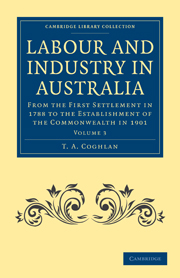 Labour and Industry in Australia
Labour and Industry in Australia XII - CURRENCY AND BANKING
Published online by Cambridge University Press: 07 October 2011
Summary
The establishment of a branch mint at Sydney removed the principal local difficulties affecting the currency, and when the Australian sovereign was placed on an equality with the British sovereign by the Order in Council of 1866, the larger problems of exchange were satisfactorily solved. In 1872 a second branch mint was opened in Melbourne, to the great convenience of the local gold producers. The authority to coin silver was not given to the branch mints, and, as the English Government considered that the grant of responsible government relieved it of the necessity of looking to the supply of currency in the colonies to which the privilege was granted, the duty of maintaining the sufficiency and quality of the silver and copper currency fell upon the local authorities. The various Governments and the banks allowed matters to drift, no one being willing to undertake the trouble and expense of renewing the silver and copper currency. It is not surprising, therefore, that at the beginning of this period all the Australian communities suffered from a lack of small change, and as the years went by, the want of a sufficient quantity of good silver and copper money became a great hindrance to retail business, and in many parts of the country payments other than in gold were practically impossible.
- Type
- Chapter
- Information
- Labour and Industry in AustraliaFrom the First Settlement in 1788 to the Establishment of the Commonwealth in 1901, pp. 1206 - 1217Publisher: Cambridge University PressPrint publication year: 2011First published in: 1918
